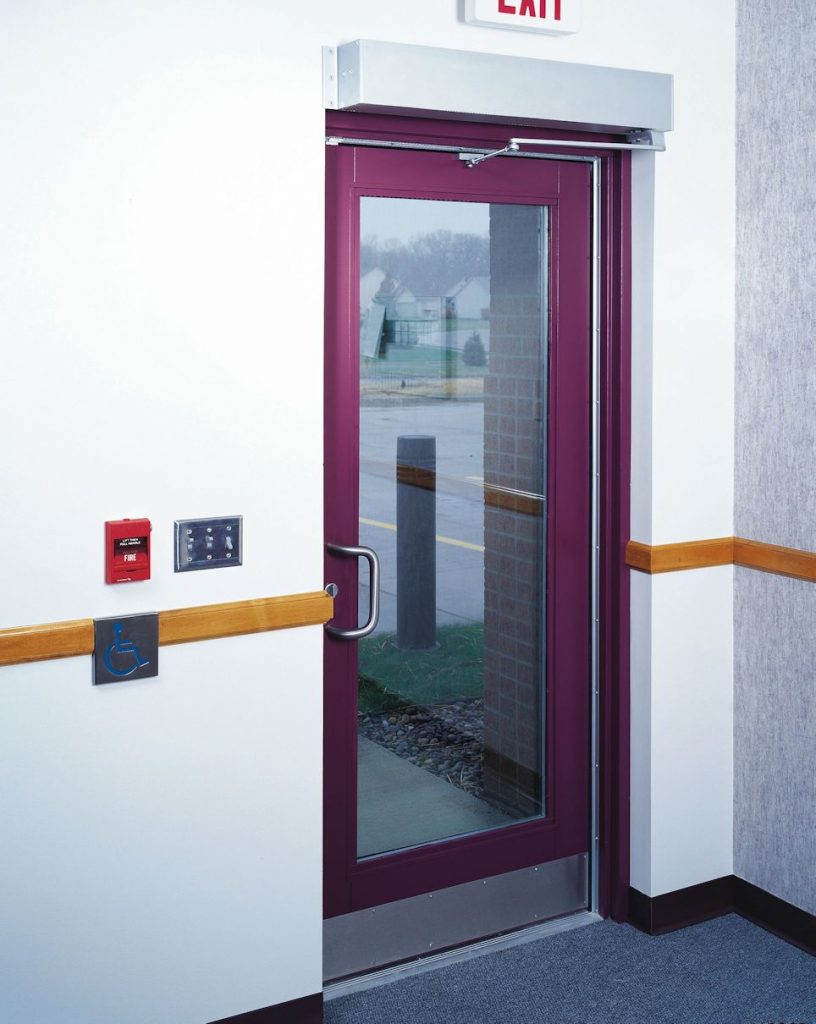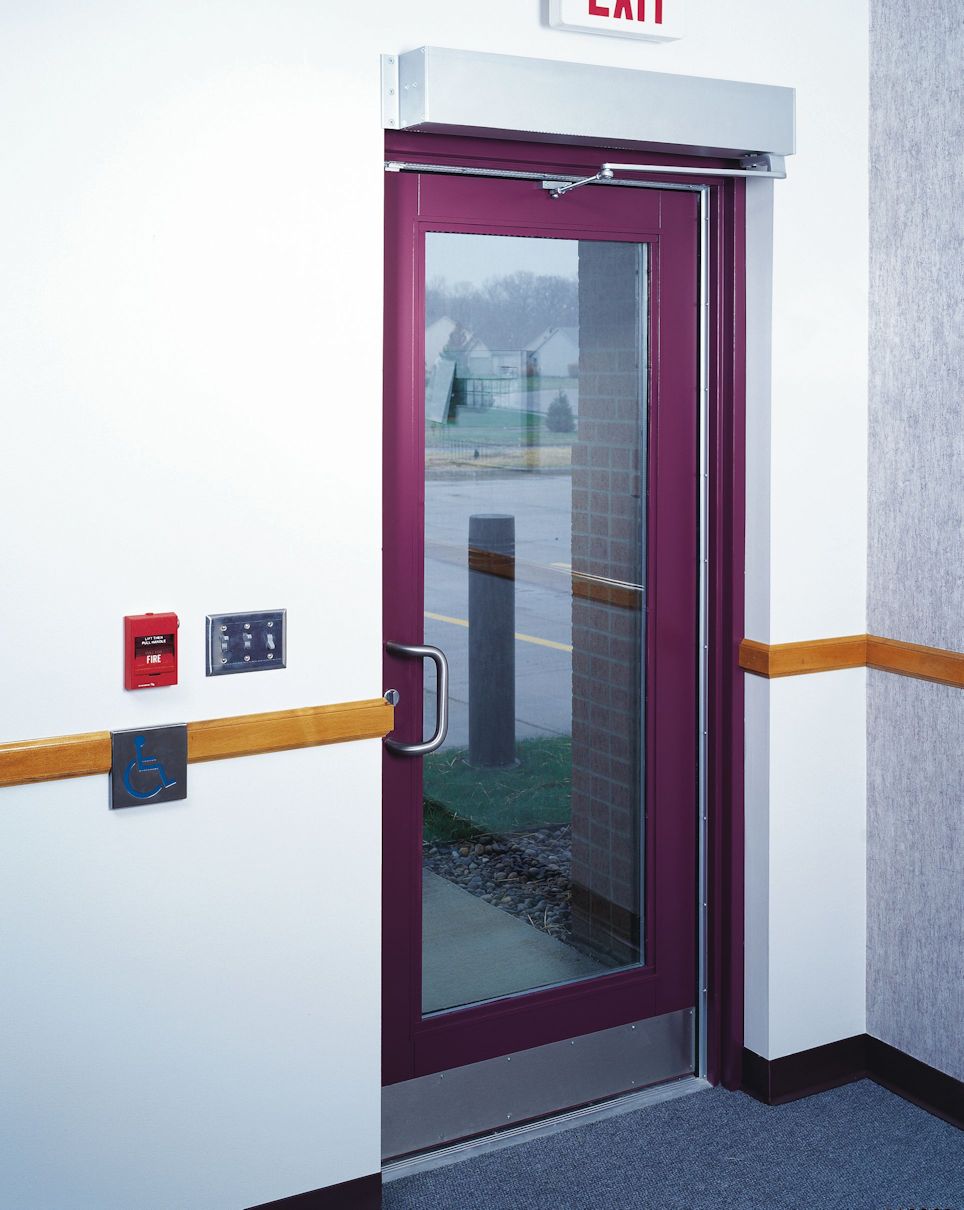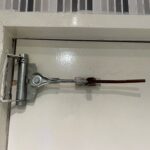 Doors with low-energy automatic operators are often installed in locations where they may be opened either automatically or manually, depending on the needs of the person opening the door. Because low-energy operators are required to open slowly, it is often more convenient to use the door manually. The codes and standards limit the opening force for interior, non-fire-rated, manually-operated doors to 5 pounds, hence the question…
Doors with low-energy automatic operators are often installed in locations where they may be opened either automatically or manually, depending on the needs of the person opening the door. Because low-energy operators are required to open slowly, it is often more convenient to use the door manually. The codes and standards limit the opening force for interior, non-fire-rated, manually-operated doors to 5 pounds, hence the question…
“Does an automatic door have to comply with the 5-pound limit when it is operated manually?”
This question has a pretty straight-forward answer (“no”) but there is a conflict you should know about. The accessibility standards include two separate sections addressing automatic doors and manual doors. If a door has an automatic operator, it is an automatic door, even if the door is sometimes used manually.
Here is the paragraph from the MANUAL DOOR SECTION of the 2010 ADA Standards:
404.2.9 Door and Gate Opening Force. Fire doors shall have a minimum opening force allowable by the appropriate administrative authority. The force for pushing or pulling open a door or gate other than fire doors shall be as follows:
1. Interior hinged doors and gates: 5 pounds (22.2 N) maximum.
2. Sliding or folding doors: 5 pounds (22.2 N) maximum.
These forces do not apply to the force required to retract latch bolts or disengage other devices that hold the door or gate in a closed position.
The automatic-door sections of the accessibility standards do not include a limit on opening force – the 5-pound limitation for interior, non-fire-rated doors is only in the manual door section, so the accessibility standards do not limit the amount of opening force for an automatic door.
That doesn’t mean that there are no limitations on the manual opening force for an automatic door. The International Building Code (IBC) includes opening force limits for manual doors and automatic doors*:
Manual Doors:
The force to open doors shall comply with the following:
1. For interior swinging egress doors that are manually operated, other than doors required to be fire rated, the force for pushing or pulling open the door shall not exceed 5 pounds (22 N).
2. For other swinging doors, sliding doors or folding doors, and doors required to be fire rated, the door shall require not more than a 30-pound (133 N) force to be set in motion and shall move to a full-open position when subjected to not more than a 15-pound (67 N) force.
Location of applied forces. Forces shall be applied to the latch side of the door.
Automatic Doors:
Where means of egress doors are operated or assisted by power, the design shall be such that in the event of power failure, the door is capable of being opened manually to permit means of egress travel or closed where necessary to safeguard means of egress. The forces required to open these doors manually shall not exceed those specified in Section 1010.1.3, except that the force to set the door in motion shall not exceed 50 pounds (220 N). The door shall be capable of opening from any position to the full width of the opening in which such door is installed when a force is applied to the door on the side from which egress is made. Power-operated swinging doors, power-operated sliding doors and power-operated folding doors shall comply with BHMA A156.10. Power-assisted swinging doors and low-energy power-operated swinging doors shall comply with BHMA A156.19. Low-energy power-operated sliding doors and low-energy power-operated folding doors shall comply with BHMA A156.38. (refer to the IBC for exceptions)
So – the IBC allows manually-operated automatic doors to require up to 50 POUNDS to set the door in motion, and 15 pounds to open the door to the fully-open position. BUT…the IBC also requires doors with low-energy or power-assist operators to comply with BHMA A156.19, and power-operated doors to comply with BHMA A156.10. Here’s where the conflicts arise, because these standards include more stringent requirements than the IBC.
Automatic Doors with Low-Energy Operators or Power-Assist Doors (A156.19):
4.5 …Doors shall open with a manual force not to exceed 15 lbf (67 N) to release a latch, if equipped with a latch, 30 lbf (133 N) to set the door in motion, and 15 lbf (67 N) to fully open the door. The forces shall be applied at 1 inch (25 mm) from the latch edge of the door.
Power-Operated Doors (A156.10):
10.2.8 In the event of power failure, a swing door shall be capable of being opened manually with no greater than a 30 lbf (133 N), applied 1 in. from the edge of the lock stile to open.
10.2.9 Swinging doors provided with a break away device shall require no more than 50 lbf (222 N) applied 1 in. from the edge of the lock stile to open. When the door(s) is opened in the break out mode, powered operating components excluding spring power shall not operate the doors.
In summary…
- Interior, non-fire-rated, manually-operated swinging doors – limited to 5 pounds by the accessibility standards and the IBC.
- Fire-rated, manually-operated swinging doors – 30 pounds to set the door in motion, and 15 pounds to open the door to the fully-open position – per the IBC. NFPA 80 recommends a size-4 closer for exterior fire doors and a size-3 closer for interior fire doors.
- Exterior, manually-operated swinging doors – 30 pounds to set the door in motion, and 15 pounds to open the door to the fully-open position – per the IBC, or as limited by state and local codes.
- Doors with low-energy or power-assist operators – 30 pounds to set the door in motion, and 15 pounds to open the door to the fully-open position – as required by BHMA A156.19 which is more restrictive than the IBC.
- Power-operated pedestrian doors – 30 pounds to set the door in motion, and 15 pounds to open the door to the fully-open position, except 50 pounds if the door has a break-away feature – as required by BHMA A156.10, which is more restrictive than the IBC.
Keep in mind that state and local requirements may vary from the codes and standards referenced here.
*Where the accessibility standards include a more stringent requirement (like the 5-pound limit on interior, non-fire-rated, manually-operated doors), the limitations stated in the accessibility standards would apply, not the less-stringent requirements of the building code.
You need to login or register to bookmark/favorite this content.







Good information Lori. I’m going to have to break out my pressure guage and check some doors.
We prefer to set the opening speed on our openers quite slow as the kids in our schools will take the easiest way through the opening,
although they are impatient so don’t like to wait for a slow opening door.
One of our school secretaries came up with a sign with a wheelchair reading, “Don’t use it if you don’t need it”. It actually worked and we now have them by every actuator.
The sign is a good idea. Sometimes people need a little reminder.
– Lori
could you add the ADA / ANSI A117.1 text for the 5# limit? Just so we can see that it excludes non-fire-rated doors, etc.
Done!
– Lori
Has anyone address the point that @ 5lb there’s not enough power left to actually close(latch) the door in most applications?
actually, me thinks the doors that kids would ‘slam thru’ when hastily exiting should have a healthy
backcheck set to ‘check’ those little buggers into ‘jolt’ of reality.. a reasonable amount of speed
allowed…
What does BHMA stand for
Hi Terry –
BHMA stands for the Builders Hardware Manufacturers Association. https://buildershardware.com/
– Lori
Thank you Lori
Lori,
Interior, non-fire-rated, manually-operated swinging doors – limited to 5 pounds by the accessibility standards and the IBC.
Does this mean doors without door closer, I work in a health care facility and I have been told to go by NFPA 101 and this is what it states, that is why I’m asking if this 5 pounds is only for doors without a door closer.
NFPA 101: Life Safety Code, 2012 Edition
7.2.1.4.5 Door Leaf Operating Forces.
The opening forces for interior side-hinged or pivoted swinging door leaves without closers shall not exceed 5lbf (22 N).
Hi Terry –
The 5-pound limit set by the accessibility standards applies to non-fire-rated interior doors – with or without closers. It looks like NFPA 101 is less stringent than the accessibility standards and the IBC.
– Lori
Thank you
Lori, what classifies as a exterior fire door I thought all exterior doors were non rated doors I see were it says NFPA 80 recommends a size-4 closer for exterior fire doors and a size-3 closer for interior fire doors.
Hi Terry –
Most exterior doors are not fire-rated, but occasionally a rated door is required on the exterior – usually because of the close proximity of another building or a hazard. It’s not common at all.
– Lori
Lori,
I’m trying to learn all I can, and being able to ask you question is a big help.
Thank you,
Feel free to ask any time!
– Lori